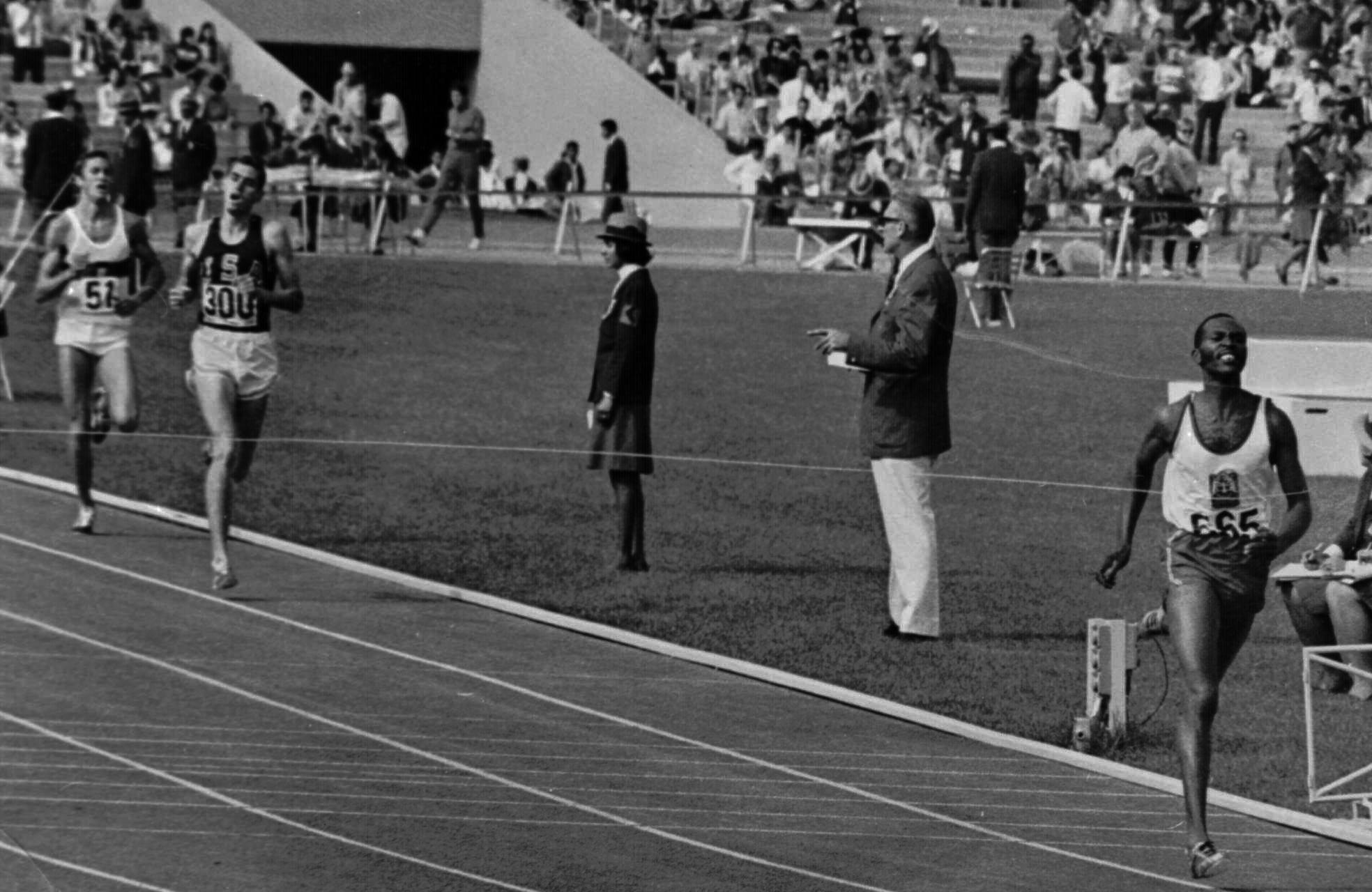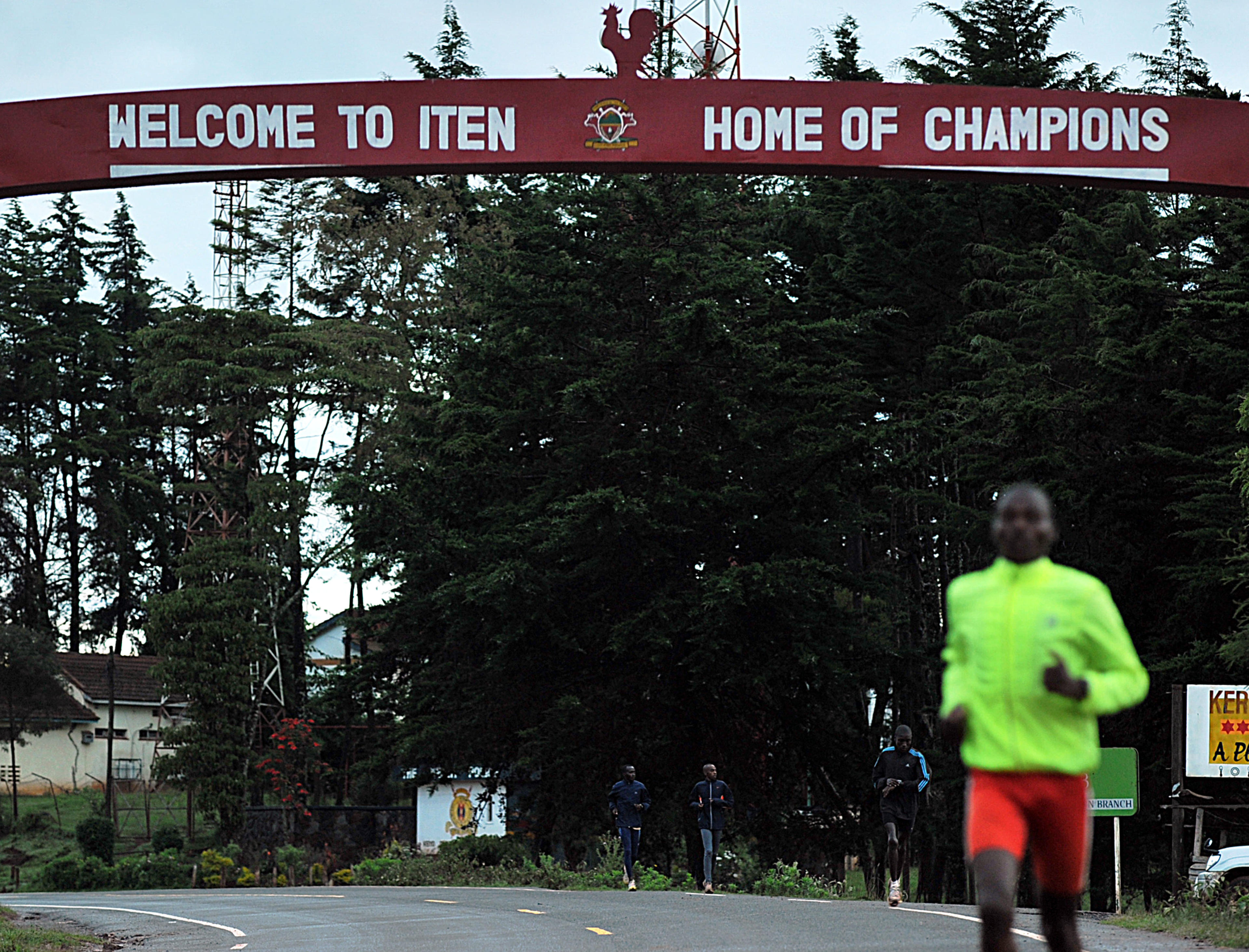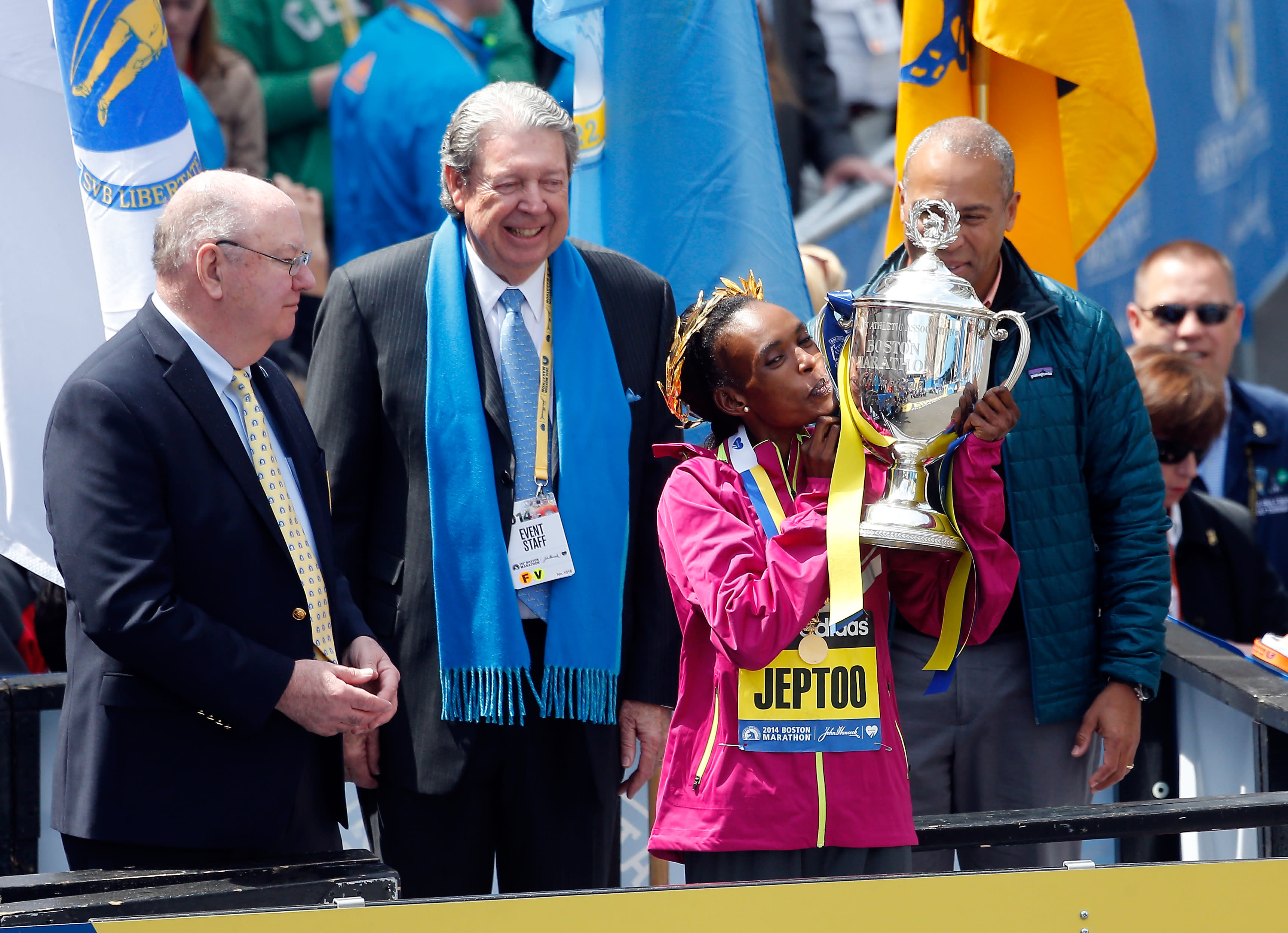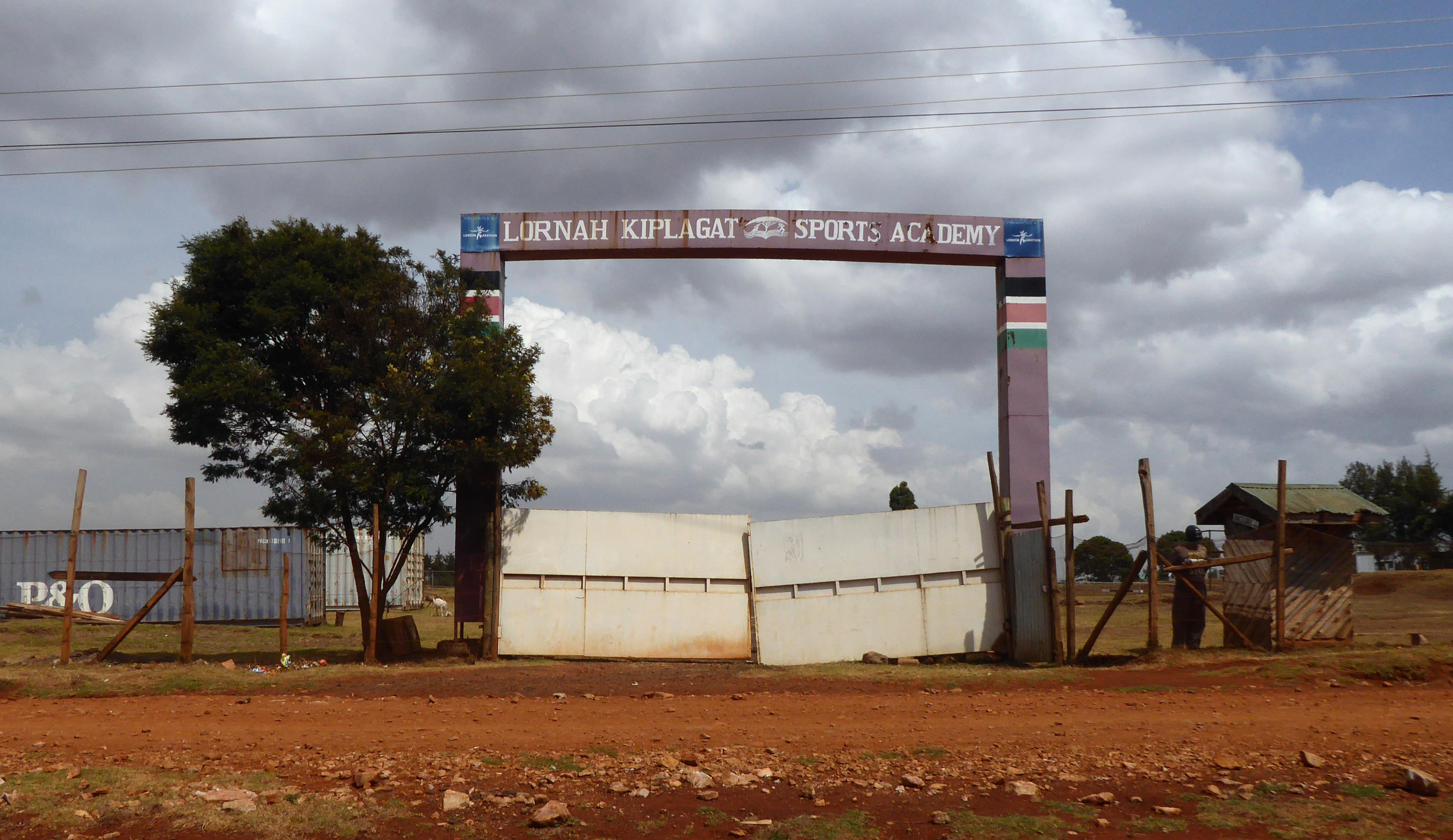PARIS — On the eve of the biggest race of her life, 21-year-old Lornah Kiplagat left home with only spare change in her pocket.
She journeyed more than six hours on a crowded bus, storefronts and scenery whizzing by until she finally arrived in Nairobi.
Adrift in Kenya’s sprawling capital city with no money for food or a place to stay, Kiplagat began to panic with nightfall fast approaching. She and a travel companion approached strangers to ask how to get to the thoroughbred racecourse that the next morning would serve as the venue for Kenya’s 1995 national cross-country championships.
When they finally made it, Kiplagat and her friend scoured the race site for somewhere to sleep. They resorted to sneaking into a public toilet and using cardboard boxes to barricade the door. Then they lay down on the floor and tried to get some rest, one on one side of the toilet and one on the other.
ADVERTISEMENT
Advertisement
“We were afraid to go anywhere else,” Kiplagat told Yahoo Sports. “We were safe and that was our happiness.”
The next morning, despite not having eaten for more than 18 hours, Kiplagat donned her race bib and cross-country spikes and joined the throng of runners at the starting line. She placed sixth and qualified to represent Kenya at the world championships, an early breakthrough on her way to becoming a three-time Olympian and the winner of marathons in Los Angeles, Osaka, Rotterdam and Amsterdam.
Kiplagat’s story helps unravel the mystery that has fascinated observers for decades: What is the secret behind Kenya’s distance-running domination? How has one East African nation piled up 50 distance-running medals in the past four Olympics alone? How did Kenya produce 18 men last April who ran the marathon faster than two hours, eight minutes when only six Americans have ever done that?
Genetic advantages alone aren’t responsible for Kenya’s success. Nor is it solely a product of the high-altitude plateaus and mild climate of Kenya’s Great Rift Valley, a runner’s paradise that has produced most of the country’s distance-running champions.
The single biggest reason is the deep motivation many Kenyans feel not just to chase distance running glory but to keep pursuing it under circumstances that would drive athletes from other parts of the world to quit. In a country where higher-education opportunities are scarce and even university graduates struggle to find high-income jobs, young Kenyans often view running as one of the few available paths to a better life.
ADVERTISEMENT
Advertisement
Every year, several thousand of Kenya’s fastest amateur runners flock to Iten, Kaptagat and other high-elevation towns that are home to well-funded training groups. They train every day, often in second-hand running shoes. They scrounge up just enough money to pay for a bed to sleep in and food to sustain themselves.
The competition is cutthroat to catch the eye of a foreign coach and earn the chance to compete overseas for life-changing prize money. In the past decade, that has resulted in an avalanche of anti-doping violations and has raised suspicions that Kenya’s distance-running ascendance isn’t the fairytale it was once thought to be.
“The doping problem in Kenya is devastating,” said Claudio Berardelli, a prominent Italian distance-running coach whose training group is based in Kapsabet. “Many athletes have fallen victim to the temptation. All of a sudden, in a short period of time, it was like, ‘What is happening? Were we blind?’”


The emergence of the African distance runner
Hard as it is to believe now, there was a time when Kenyans distance runners were viewed as afterthoughts.
ADVERTISEMENT
Advertisement
The misperception in the British press was that African runners lacked the stamina or tactical acumen to challenge the Europeans who had dominated the middle- and long-distance events for decades.
In 1954, back when Kenya was still under British colonial rule, Lazaro Chepkwony became the country’s first runner to compete internationally. He drew attention at his debut meet in London for more than just running barefoot on White City Stadium’s cinder track.
At the start of the 6-mile race, Chepkwony charged to the lead and opened a gap on the rest of the field. Then he slowed down to allow the other competitors to catch up. He repeated this unorthodox strategy several more times during the first half of the race before dropping out with a pulled muscle.
Only a day later, another Kenyan shocked the London crowd in the 3-mile race with his bare feet and audacious strategy. Nyandika Maiyoro roared to the front and ran six laps at world-record-shattering pace, bravely holding on for third place and a new Kenyan record even after two other runners overtook him.
John Bale and Joe Sang, authors of the 1997 book “Kenyan Running,” collected press clippings from after those races, as did Graham Huggan, who wrote the Oxford Handbook of Postcolonial Studies. The reaction to the performances of Chepkwony and Maiyoro reflected the social prejudices of the era and how dismissive the British public was to the challenge posed by the African runners.
ADVERTISEMENT
Advertisement
The 6-mile event was “bedevilled” by the antics of Chepkwony, the Manchester Guardian reported. The race was “enlivened and also robbed of its customary rhythm and stately order,” The Times grumbled. The Guardian’s account of Maiyoro’s performance described his early pace as “ludicrously fast,” while The Times claimed it was “inevitable” that the Kenyan would eventually be caught and left behind.
The most prescient assessment of Maiyoro’s strong showing came from Athletics Weekly founder Jimmy Green.
“Never again shall we nurse the idea,” he wrote, “that the coloured races are no good at anything beyond a mile.”
Over the next decade-plus, Kenyan distance-running pioneers studied their European and American counterparts and performed well enough to hint at the tsunami of gold medals and world records to come. By the 1968 Mexico City Olympics, Kenya had produced a runner capable of obliterating lingering stereotypes and inspiring a generation of kids to dream big.
Kipchoge Keino was among the leaders late in the men’s 10,000-meters in Mexico City until he experienced severe pain in his side and collapsed to the track. He returned for the 5,000 meters a few days later, winning silver despite a recurrence of his abdominal pain.
ADVERTISEMENT
Advertisement
Doctors diagnosed Keino with a gallbladder infection and warned him not to run the 1,500-meter final, but he could not bear leaving Mexico without bringing home a gold medal. He caught a bus to the stadium, famously jogging the final mile or so by foot after encountering a traffic jam.
The overwhelming favorite to win the 1,500 was American world record holder Jim Ryun, who hadn’t been beaten at that distance in three years. Keino set a torrid early pace and opened an astonishing gap over Ryun, nullifying the American’s fearsome last-lap kick and leaving him way too far behind to catch up.
In all, Kenyan runners won eight Olympic medals in Mexico City, the 7,349-foot elevation no doubt contributing to their success. Keino and his countrymen trained year-round in Kenya’s high-altitude Rift Valley region, adapting them to the oxygen-starved air in a way that European or American runners weren’t.
“There are a lot of us who’d like to race the Kenyans somewhere else,” Australian distance runner Ron Clarke told Track and Field News at the time.
Seldom did the rest of the world fare any better at sea level. One after another, more Kenyans emerged and dominated the track and the road.


‘They train without realizing they train’
Betsy Saina comes from a remote village of farmers and livestock breeders in the lush, green highlands of Kenya’s Great Rift Valley. It’s a place where electricity and indoor plumbing are uncommon, where roads are unpaved and where cars are luxuries most families can’t afford.
ADVERTISEMENT
Advertisement
The elementary school that Saina attended was about 3 kilometers from her home. Each day, she’d run to school, back home for lunch and then repeat the round trip again, traversing rugged, hilly terrain with a book bag slung over her shoulder.
Saina journeyed similar distances when her parents requested she hunt for firewood in the bush or retrieve water from the river. Once, when one of the family’s cows got sick, Saina pocketed the cash her dad gave her to pay for a ride to the nearest store and ran the equivalent of a half marathon to fetch medicine.
“Everything when I was young was kind of a struggle to be honest with you,” Saina told Yahoo Sports, “but things happen for a reason.”
Those childhood runs at 8,000-feet elevation gave Saina an edge when she decided to pursue distance running. By 2013, she was an NCAA champion. By 2016, an Olympian. By 2018, the winner of the Paris Marathon.
Across the Rift Valley, generations of schoolchildren have grown up similarly to Saina. They unknowingly build aerobic endurance at the same age that future distance runners from other countries are riding bicycles, cars or school buses.
ADVERTISEMENT
Advertisement
“They train without realizing they train,” Kiplagat said.
Whereas America’s most promising young athletes might aspire to be the next LeBron James, Serena Williams, Simone Biles or Patrick Mahomes, the range of opportunities for Kenyan kids isn’t nearly as diverse. There are few Kenyans playing professional soccer or basketball abroad and none at an elite level. It has been 36 years since Kenya last produced an Olympic medalist in anything besides track and field.
Kenyan distance runners, by contrast, are smashing records and outracing top competition from around the world. Young kids notice that Kenya’s Olympic champions live in mansions, drive luxury cars and lift their parents and siblings out of poverty. They grace billboards, appear in commercials and lead the nightly news. Those runners represent the dream in a country where there are few other potential paths to a better life.
“Imagine you’re a young girl born in a village,” said Gabriele Nicola, an Italian coach who runs a training camp in Iten, the Rift Valley’s famed Home of Champions. “If you won a minor race in Europe, you might take home 2,000 Euros, 3,000 Euros. That’s a full year of salary for a lady working as a waitress in the biggest hotel in Iten. So simply you try. You don’t know if you’re strong or not, but you saw your sister, your cousin, the wife of your brother or whatever run fast and go abroad and win money. So you try too.”
On any given morning in Iten, as many as 900 elite runners gather silently in packs of 15 or 20 and then disperse to begin grueling training runs. They run for miles and miles on the rocky, red-dirt roads outside of Iten, snaking through farmland and rolling hills at an intimidating pace.
ADVERTISEMENT
Advertisement
About 10% are true professional athletes, Nicola estimates. They compete internationally in marquee track and road races that offer five- or six-figure appearance fees and prize money. Sponsors pay for their shoes and gear and offer lucrative bonuses for notable victories or world-record times.
Another 20%, Nicola says, “survive race-to-race.” They pocket $1,000 here or there competing in lower-level races, all the while hoping that years of rigorous training will produce a breakthrough time and a big-money sponsorship deal.
The rest are fueled by reckless optimism. They descend upon Iten from across Kenya, hoping to catch the eye of the coach of a major training group there. A few display world-class talent and eventually run their way out of poverty. Most waste the best years of their lives chasing a dream that stays perpetually out of reach.
“It’s really terrible,” Nicola said. “At 28, 29, 30 years old, they go back to their village, more poor than before and more disappointed than before. Less than three years later, maybe you read in the media that they’ve passed away from cirrhosis because they started to drink too much.”
The pros-to-joes ratio is similar in towns across the Rift Valley where independent runners can hope to latch on with a training group. In the U.S. or Europe, a runner struggling to earn a living might quit to pursue other career paths. In Kenya, amateur runners often keep training full-time into their late 20s and 30s, driven by the chance to improve their lives and the lack of better job opportunities.
ADVERTISEMENT
Advertisement
Almost every day, Berardelli said, he or his assistants come across someone begging, “‘Please help me with shoes” or “Let me come join your group.” Usually, the Italian coach has to say no, but occasionally he uncovers a late-blooming talent who has gone overlooked.
Nine years ago, one of Berardelli’s assistant coaches asked him to give a 24-year-old runner a tryout. The assistant coach told Berardelli that this kid had been running for years while working on his family’s farm and was “pressuring” him for a chance.
At first, when Benson Kipruto struggled to keep pace, Berardelli admits, “I wasn’t giving him much attention.” Then little by little Kipruto kept getting faster, so much faster that he won the Boston Marathon in 2021, the Chicago Marathon in 2022 and the Tokyo Marathon earlier this year.
“Now he’s maybe one of the guys who can win the Olympic marathon,” Berardelli said.


Motivation to dope
Kenyan distance runners’ deep-rooted motivation to escape poverty has propelled them to unprecedented success. It also, in the words of World Athletics’ top anti-doping official, has created “a temptation to dope that’s like no other part of our sport.”
On Sept. 25, 2014, two doping control officers visited Berardelli’s training group in Kapsabet and surprised the world’s top-ranked female marathoner with a targeted drug test. Kenya’s Rita Jeptoo tested positive for EPO, a prohibited substance with a long history of abuse among endurance athletes seeking to improve stamina and performance.
Jeptoo’s lawyers tried to claim that her doctor administered the EPO because she was in a car accident and came to the Kapsabet Medicare Center in “life-threatening condition as a result of the blood she had lost.” In support of her claim, Jeptoo even produced falsified medical records.
The Court of Arbitration responded by doubling Jeptoo’s original two-year suspension to four years, describing the submission of the forged documents as “the culminating peak in an overall strategy” of deception and obstruction. Jeptoo did not withdraw the forged documents voluntarily, the Court noted in its decision, but “only when she was confronted with overwhelming evidence that her whole defense was totally made up.”
Jeptoo, at the time, was maybe the highest-profile marathon runner ever to fail a doping test. The 2014 Chicago Marathon and Boston Marathon champion was stripped of those titles and also lost the chance to collect the $500,000 prize she had been awarded as that year’s World Marathon Majors champion.
Alarmed by Jeptoo’s drug case and a spate of others involving Kenyan runners, the World Anti-Doping Agency (WADA) teamed up with the IAAF’s Athletic Integrity Unit to examine the doping practices of the country’s elite athletes. They found, through interviews with athletes, coaches and administrators, that Kenya had “a serious doping problem” but that it was “drastically different from other doping structures discovered elsewhere in the world.”
Rogue foreign coaches and agents weren’t distributing performance-enhancing drugs to Kenyan runners, as the chairman of Athletics Kenya had previously claimed. Nor was this a state-run doping system like East Germany’s or Russia’s. Kenyan athletes typically acted on their own, drawn by the chance to improve their own lives and their communities via the six-figure paydays available to the winners of the world’s most lucrative road races.
When she spoke to Yahoo Sports, Saina described having to frequently turn away opportunists peddling banned substances obtained from a hospital or pharmacy. Saina said that to this day it’s “easy” for Kenyan athletes to obtain anabolic steroids, EPO and other PEDs from unethical pharmacists and medical workers who are “desperate to make money.”
Asked about previous Kenyan runners who have insisted their failed drug tests were a result of unknowingly taking something on WADA’s prohibited list, Saina scoffed at those alibis.
“That’s bulls***, to be honest,” Saina said. “They don’t do it by mistake. They do it intentionally, knowing that this is the only way they can win money.”
The AIU sought to fight this problem by transforming Kenya from an uncontrolled environment to one with guardrails in place. It has educated Kenyan athletes about the consequences of doping, drastically increased out-of-competition testing for Kenyan runners and bolstered the country’s once-nonexistent anti-doping system.
Kenya didn’t establish a national anti-doping agency until 2016, soon after the country narrowly avoided a ban from the Rio Olympics for a series of doping offenses and corruption allegations. Only in 2022 did the Kenyan government at last publicly acknowledge the country’s doping problem and commit to spending $25 million over the next five years to combat the epidemic.
Entering the summer, a staggering 91 Kenyan track and field athletes were ineligible to compete due to anti-doping violations, according to the AIU’s global list. That group includes world record holders, Olympic gold medalists and other giants of the distance-running world.
Among the recent additions is 35-year-old Lawrence Cherono, a previous winner of marathons in Boston, Chicago and Amsterdam. In May 2022, Cherono provided an out-of-competition urine sample in Kaptagat. That test came back positive for trimetazidine, a heart medication banned by WADA in 2014.
Cherono submitted a written explanation that a local clinic prescribed heart medication to his wife and that she had accidentally given him one of those tablets instead of the painkiller he had requested. Bolstering this explanation, Cherono submitted to the AIU medical documents from the clinic.
For nearly two years, the AIU sought to verify Cherono’s story, only to have its investigation “materially obstructed and substantially undermined.” Only with the help of a court order did the clinic finally confirm last April that Cherono’s wife had not been treated for a heart condition and that the documents he submitted “were not genuine.”
Cherono is serving a seven-year suspension and won’t be eligible to compete again until July 2029, one month shy of his 41st birthday. It’s an outcome that shows that World Athletics and the AIU are “determined to win the fight to clean up the sport,” Travis Tygart, CEO of the U.S. Anti-Doping Agency, told Yahoo Sports.
“Athletes around the world,” said Tygart, “ought to have more confidence than they’ve ever had that Kenyan athletes are being held to the highest of high standards by the AIU.”


‘I’d be on the C-Squad in Kenya’
For years, American distance runner Nell Rojas had been curious about how Kenya produces so many world-class marathoners. In January 2023, Rojas traveled all the way to Iten to find out for herself.
When Rojas arrived, she found what she describes as “a fairytale land for runners.” Group after group of elite runners sped past, their brightly colored running shoes leaving behind footprints in Iten’s iconic red dirt.
Rojas has placed in the top 10 of the prestigious Boston and New York marathons, but even she struggled to keep pace with the Kenyan runners she trained with in high-altitude Iten. She chuckled as she described she and Australian marathoner Matthew Fox starting a morning run with a pack of other runners, only to be “immediately dropped.”
At the end of the run, one of the Kenyan runners who left Rojas behind approached and struck up a conversation. When she mentioned that she was a cousin of Betsy Saina, Rojas told her that she knew Betsy and asked if they ever trained together.
“Oh no,” the Kenyan woman said, laughing. “She is a professional runner. I am not even close.”
At that moment, Rojas began to understand the depth of distance-running talent in Kenya. It wasn’t just the top Kenyans racing internationally who were faster than her. There were dozens more runners back in Kenya training and waiting for their chance.
“It was so humbling,” Rojas said. “In the U.S., I’m one of the top marathon runners. I’d be on the C-Squad in Kenya.”
Rojas is far from the only foreigner to make a pilgrimage to Iten. Thousands of runners flock to Kenya’s “Home of Champions” each year, some seasoned pros seeking strong competition and fresh training methods and others amateurs eager to test themselves on the same rolling hills and terrain traversed by the best in the world.
Among the first to recognize Iten’s potential as a tourist destination was Lornah Kiplagat, the future Olympian and marathon champ who slept beside a Nairobi public toilet the night before her first big race.
In 1997, Kiplagat purchased a plot of land in Iten and started building a training center dedicated to helping teenage Kenyan girls pursue running careers while furthering their education. Over the years, Kiplagat has opened her doors to athletes and tourists from all over the world, with a chunk of the profit paying for the school fees of young female runners who want to go to class while training.
Up to 72 people at a time now stay at the High Altitude Training Center and enjoy its 25-meter swimming pool, fully equipped gym and sauna. Guests range from reigning Olympic champions, to national teams from all over the world, to recreational runners who struggle to run a half marathon in less than three hours.
Every first-time visitor, Kiplagat says, wants to know the secret to Kenya’s distance-running domination. Kiplagat always encourages them to go find out for themselves. Show up to a Tuesday morning 15K along the scenic dirt roads outside Iten. Start alongside 100-plus other runners. See how hard everyone pushes themselves trying to stay in contact with the leaders.
To Kiplagat, those grueling training runs reveal Kenya’s bittersweet reality.
“The difference between Kenyans and Western people,” Kiplagat says, “is that Western people have choices: they can run, they can work, they can study or they can do nothing and still make a living. Kenyans have no options. They need to work extremely hard to survive and that’s very good and strong motivation.”
